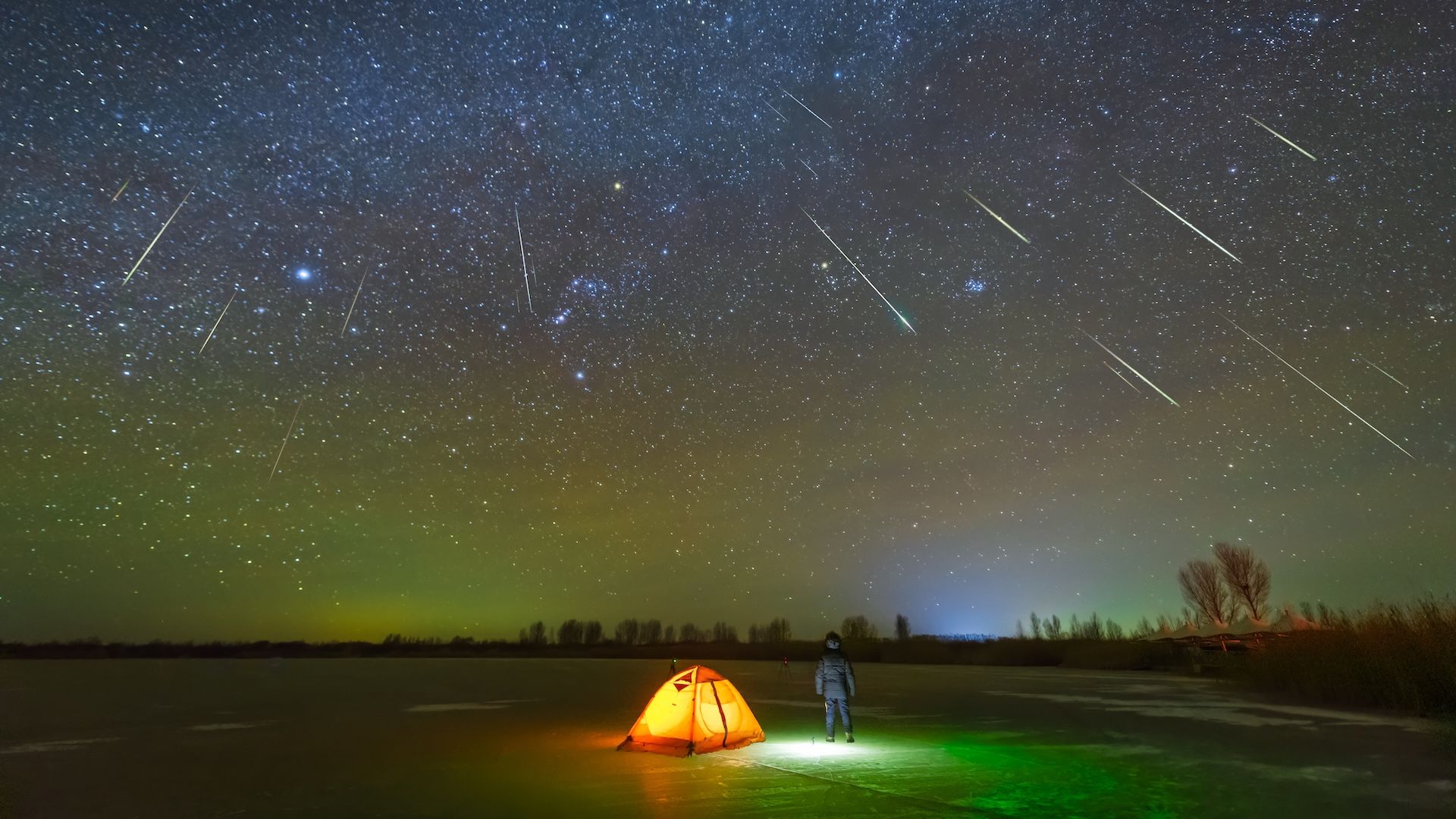The night sky in Wisconsin glows with the Northern Lights as a geomagnetic storm brings vibrant pink and green colors to a majority of the northern states. (Photo by Ross Harried/NurPhoto via Getty Images)
NurPhoto via Getty Images
The Northern Lights may be visible on camera — and possibly to the naked eye — across northern and upper Midwest states, from New York to Idaho, as soon as it gets dark on Thursday, Oct. 16, 2025, according to a forecast from the National Oceanic and Atmospheric Administration’s Space Weather Prediction Center (SWPC).
The forecast includes a G2 geomagnetic storm that could make the aurora borealis visible from as many as 16 U.S. states. The latest has a G2-rated geomagnetic storm beginning around 21:00-0:00 UT (4:00-7:00 p.m. EDT) on Thursday, Oct. 16, though timings are approximate.
It comes days before the annual peak of the Orionid meteor shower and just as comets Lemmon (C/2025 A6) and SWAN (C/2025 R2) can be seen after sunset from the Northern Hemisphere in binoculars.
Check my feed every day this month for a daily “comet tracker” with finder charts and tips for viewing Comet Lemmon and Comet SWAN from mid-northern latitudes.
Northern Lights Forecast: What To Expect
The latest forecast calls for a G1-rated geomagnetic storm on Thursday, Oct. 16, but stronger G2 conditions could ensure, which could push the auroral oval farther south than usual — making this an alert worth watching.
According to Spaceweather.com, two small coronal mass ejections were hurled in the direction of Earth on Oct. 13, with their combined effect possibly sparking a geomagnetic storm. A coronal mass ejection (or CME) is a cloud of magnetic fields and charged particles from the sun that stream into space at up to 1,900 miles (3,000 kilometers) per second.
“Geomagnetic field activity will likely reach G2 (Moderate) storm levels late on 16 Oct in response to CMEs that left the Sun over the course of 11-13 Oct affecting the near-Earth environment,” stated NOAA. “G1 (Minor) geomagnetic storm activity is then likely to carry over into 17 Oct. Quiet to unsettled conditions are expected to prevail on 18 Oct as any post CME effects wane.”
NOAA’s aurora viewline for Thursday, Oct. 16, 2024.
NOAA
Where And When To See Northern Lights
NOAA’s latest aurora viewlines indicate that aurora displays are a possibility in northern U.S. states and Canada, with 16 U.S. states having a chance after dark on Thursday, Oct. 16.
U.S. states that may see aurora include Alaska and (northerly parts of) Washington, Oregon, Idaho, Montana, Wyoming, North Dakota, South Dakota, Minnesota, Iowa, Wisconsin, Michigan, New York, Vermont, New Hampshire and Maine.
Dark northern skies away from urban light pollution are likely to offer the best views.
How to find Comet Lemmon, 90 minutes after sunset, from Oct. 13-24, 2025.
Stellarium
Where And When To See The Comets
A bright comet is rare, but two comets visible through binoculars at the same time? Unheard of. Comets Lemmon (C/2025 A6) and SWAN (C/2025 R2) can be found in the northwest and southwest, respectively, and are best seen during a 30-minute window beginning about 90 minutes after sunset. They’re predicted to reach their peak brightness early next week.
How to find Comet Lemmon, 90 minutes after sunset, from Oct. 13-31, 2025.
Stellarium
Where And When To See ‘Shooting Stars’
The result of debris left behind by Halley’s Comet, the Orionid meteor shower reaches its peak overnight on Monday, Oct. 20, through Tuesday, Oct. 21, 2025. However, it’s producing meteors right now as Earth plows through its dust stream, producing fast, bright meteors that streak across the sky. They appear to radiate from the constellation Orion, though they can be seen in any part of the sky.
NOAA’s storm watch for a G2 geomagnetic storm on Oct. 16, 2025.
NOAA
Where To Get The Latest Northern Lights Forecast
All forecasts for the aurora must be treated with caution. To check visibility in real time, use NOAA’s 30-minute aurora forecast, or download apps such as Aurora Now, My Aurora Forecast or Glendale Aurora for up-to-the-minute alerts and live solar wind data.
Aurora-chasers frequently use the Kp index to predict the intensity of a geomagnetic storm, but for aurora displays, the interplanetary magnetic field’s Bz component is more important (you’ll find it in some of the above apps and on SpaceWeatherLive.com).
Bz determines how easily solar energy enters Earth’s magnetosphere. When Bz points north, Earth’s field resists it; when Bz swings south, the two fields connect, allowing plasma to stream in. A sustained southward Bz of −5 nT or stronger usually signals an imminent display of aurora.
Wishing you clear skies and wide eyes.
Source link


